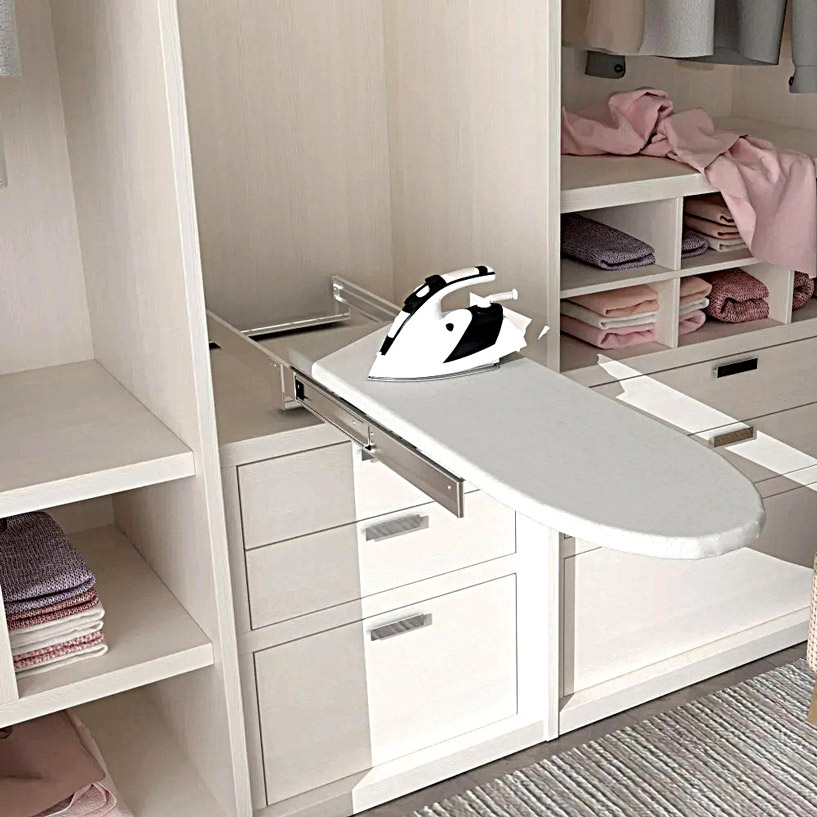
Designing an effective wardrobe involves much more than just adding a few extra shelves and shoe racks. Despite the distinct requirements of men, women, and children, we often fall into the trap of adopting a one-sizefits- all approach to wardrobe design. However, there’s a reason why closet design is a specialized field - it requires careful consideration of individual needs and lifestyle habits. Opting to design your own custom closet without understanding these nuances can lead to problems that may only become apparent later on. To steer clear of these potential pitfalls, it’s crucial to grasp the most common mistakes in closet design. Furniture Design & Technology (FDT) consulted with renowned interior designers and wardrobe manufacturers to unveil the common errors to avoid when designing wardrobes.
It’s imperative to avoid adopting a uniform wardrobe design for men, women, and children, as their needs greatly differ. Women’s wardrobe design requires meticulous attention to detail. Women often require more storage space for accessories, including delicate items like jewelry and scarves.
To cater to these needs, consider incorporating features like jewelry organizers to neatly arrange rings, necklaces, and earrings. Dedicated watch compartments provide a designated space for timepieces, ensuring they remain in optimal condition. Additionally, allocate specific zones for scarves, socks, hosiery, belts, and other accessories, whether through hooks or shelves. Additionally, explore options like wall-mounted racks and slideout compartments to enhance organization and efficiency.
Men’s clothing typically demands more hanging space, especially for suits and jackets. It’s crucial to ensure there’s ample room for these garments, along with double hangers for shirts and pants to prevent creasing and maintain their form. Incorporating pull-out or pivot pant racks offers a practical solution to keep trousers wrinkle-free and facilitates easy selection. Utilizing hooks to store caps, hats, belts, and backpacks, either inside the wardrobe or on the door, can optimize space efficiently. Customized pull-out drawers for shoes can cater to those who prioritize footwear organization, ensuring they are neatly separated from clothing and accessories. Moreover, integrating open shelves and versatile storage spaces inside the wardrobe can provide additional advantages in terms of both storage and aesthetics.
Children’s closets should be designed with both functionality and enjoyment in mind. Incorporating spacious drawers for toys encourages tidiness and facilitates easy cleanup. Low-height mirrors promote independence as children learn to dress themselves and accommodate their growth over time. Maximizing space with adjustable shelves caters to their growing needs, while ensuring easy access to clothes with hanging rods and utilizing baskets for small items. Safety is important too, so use materials that are safe for kids, like avoiding sharp edges and using child-friendly materials. Adding locks to doors and using non-toxic paint also keeps kids safe.
.jpg)
Overlooking room layout when planning your wardrobe can greatly impact the effectiveness of your wardrobe design. Smart planning is essential for maximizing space utilization.
.jpg) Surain Jain, Managing Director of Veneto, suggests, “If it’s a smaller space, the best option would be to have a sliding wardrobe which will be a space saver and style your closet with the modern profile sliders, floor to ceiling wardrobes. It will not only give you a seamless look but also add height to your room without any divisions. For a larger space, consider an Openable Hinged wardrobe, or open walk-incloset which could be on the pole system with standard accessory drawers as per your choice and functional use.”
Surain Jain, Managing Director of Veneto, suggests, “If it’s a smaller space, the best option would be to have a sliding wardrobe which will be a space saver and style your closet with the modern profile sliders, floor to ceiling wardrobes. It will not only give you a seamless look but also add height to your room without any divisions. For a larger space, consider an Openable Hinged wardrobe, or open walk-incloset which could be on the pole system with standard accessory drawers as per your choice and functional use.”
Thomas Markos, Founder, Aristo India, notices that one of the common design mistakes involves opting for shorter, seven-foot sliding doors instead of embracing the contemporary trend of floor-to-ceiling (F2C) sliding doors. He emphasizes, “While conventional sliding doors operate smoothly, F2C sliding doors offer enhanced functionality and aesthetic appeal.” Further, in today’s fast-paced fashion environment, F2C sliding doors enable seamless scaling of storage within the wardrobe’s carcass/shelves, accommodating multiple storage and hanging accessories at varying heights. Thus, overlooking the potential of F2C sliding doors may limit the optimization of both the aesthetic and practical aspects of wardrobe design.
Proper lighting is often underestimated in custom wardrobe design. Dim lighting can hinder navigation and item location, especially during busy mornings. Annkur Khosla, Founder of Annkur Khosla Design Studio, advises customizing your closet storage system with lighting options such as puck or strip lights to effectively illuminate shelves and drawers.
“Additionally, consider installing l ow-voltage LED bulbs to improve visibility in less accessible areas, ensuring a tailored lighting solution that suits your preferences,” suggests Priyanka Khanna of 42 MM Architecture.
Jain also emphasizes the importance of a well-lit wardrobe in transforming the ambiance of your closet. He recommends considering sensor lights to ensure everything is easily accessible and visible when the wardrobe door is opened.
Take care of the corners in your closet. Many people don’t realize their importance and end up cluttering them with unnecessary items. But nowadays, there are great options available, like special shutters, to fully utilize this space. You can make the most of it by adding hanging rods, installing roller corners, and incorporating drawers. So, don’t let your corner space go to waste.
Don’t forget to utilize every corner of your closet—they offer valuable storage opportunities. Use shutter options to maximize space and keep items organized and out of sight when not needed. Incorporating hanging rods, roller corners, and drawers ensures you make the most of every inch of available space.
Consider adding a clothing rod into the corner. In a wardrobe, ensuring there’s enough space for hangers to hang freely is crucial. Use measuring tape to determine the space needed for hanging clothes—it typically ranges from 21” to 24” from the back wall.
Integrate hidden systems into your closet design for added convenience and organization. Consider features like a pull-out iron table that neatly tucks away when not in use, a laundry basket for effortless clothes storage, and discreet hanging space for used garments. These small details can significantly enhance the functionality of your closet. Pull-out iron tables simplify the ironing process, ensuring your clothes stay crisp and wrinkle-free. Incorporating laundry baskets promotes seamless organization and simplifies laundry tasks. By incorporating these custom designs into your closet, you can create a space that is both stylish and practical, meeting the needs of every family member. Elevate your wardrobe experience with clever organizational solutions that make getting dressed a joy every day.
Investing in high-quality materials is crucial for ensuring the longevity of your wardrobe Jain highlights the importance of choosing durable materials and fittings to maintain the visual appeal and strength of a wardrobe over time, making it a valuable investment. Selecting the appropriate plywood, internal material finish, external material finish, and fittings based on weight capacity is essential.
 Also, many individuals encounter difficulties with their closet shutters, struggling to close them or noticing issues such as getting stuck or bent. This is often attributed to the use of plywood or HDHMR shutter fronts. To address bending problems, it’s essential to opt for block board shutter fronts instead.
Also, many individuals encounter difficulties with their closet shutters, struggling to close them or noticing issues such as getting stuck or bent. This is often attributed to the use of plywood or HDHMR shutter fronts. To address bending problems, it’s essential to opt for block board shutter fronts instead.

Investing in full-height mirrors is a must-have for any closet. After all, who doesn’t enjoy seeing themselves? Ensure you include full-height mirrors either within the shutter doors or as part of an internal mirror organizer.
Mirrors not only serve practical purposes but also enhance the aesthetic appeal of your closet. Integrated full-height mirrors allow you to easily check your outfit from head to toe, while internal mirror organizers add a touch of glamour and help you locate your favorite accessories with ease.
Shelves lacking adequate depth might suffice for smaller clothing items, but longer garments such as t-shirts, pants, or shoes often protrude, leading to a cluttered appearance. To prevent this, ensure that your custom cabinet makers install deeper shelves, providing ample space for various clothing items. This eliminates the need to overcrowd shelves with t-shirts or dresses solely to maintain closet organization.
As your clothing collection evolves over time, it’s essential for your closet to adapt accordingly. Fixed wardrobe rods positioned uniformly may limit the space needed for new items such as dresses and suit coats. To address this, invest in a custom closet storage system featuring side support rails and incremental holes. This enables flexible adjustments to rods, shelves, and drawers, ensuring your closet can easily accommodate your changing collection of clothing items. “Making provision for hanging coats, long robes, foldable clothes, winter wears, and trouser pull-outs is essential for organizing your closet according to your needs and ensuring easy access,” suggests Mr. Surain.
“Prioritizing functionality and organization while incorporating personal style into the design is crucial,” adds Priyanka Khanna. “Conducting a thorough inventory of clothing and accessories, considering daily routines, and anticipating future wardrobe additions can guide a more practical design.”
Inadequate consideration of lifestyle and usage patterns is another significant factor contributing to wardrobe design errors.

People frequently fail to account for their individual storage needs based on their habits, resulting in a wardrobe that does not cater to their specific requirements. Priyanka explains this with an example: ‘For instance, someone with an extensive shoe collection may overlook the necessity for dedicated shoe racks, leading to a cluttered and congested footwear section. So, designing a custom wardrobe requires careful consideration. Rushing through the process can lead to overlooking your needs and exceeding your budget.
Instead, take the time to assess your requirements, evaluate your living space, and plan accordingly for your future wardrobe.
Furniture Design India and the magazine FURNITURE DESIGN & TECHNOLOGY (FDT magazine) are from the trusted 22-year-old media house of SURFACES REPORTER and PLY REPORTER.
FDT is a B2B monthly bilingual magazine from India that shares the pulse of the furniture business in India and connects the manufacturers, OEMS, product designers, architects, showrooms, designers and dealers.
Read More© 2025 Furniture Design and Technologies.. All Rights Reserved. Developed by eyeQ Advertising